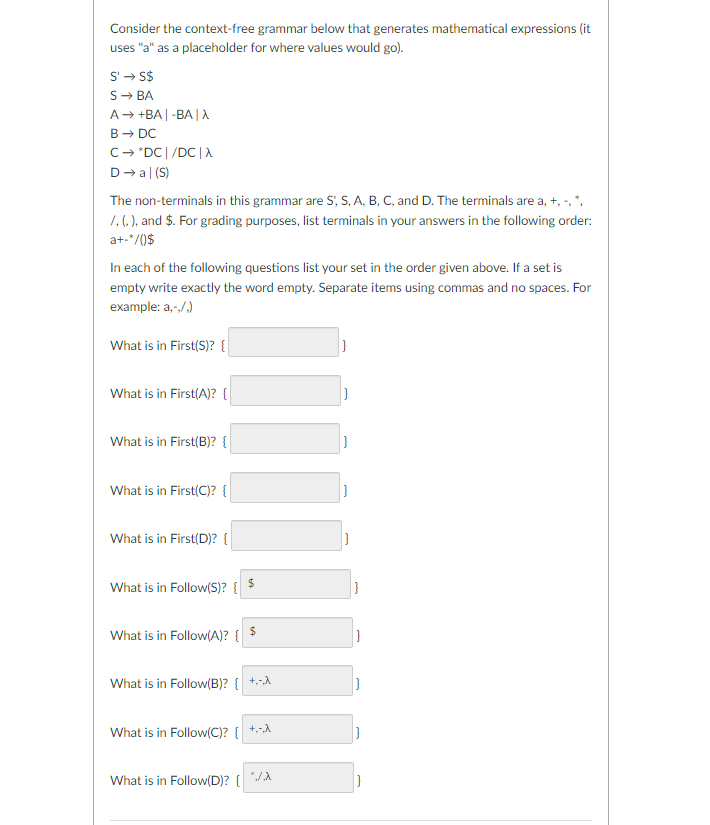low(S) Follow(A) Follow(B) Follow(C) Follow(D)
Database System Concepts
7th Edition
ISBN:9780078022159
Author:Abraham Silberschatz Professor, Henry F. Korth, S. Sudarshan
Publisher:Abraham Silberschatz Professor, Henry F. Korth, S. Sudarshan
Chapter1: Introduction
Section: Chapter Questions
Problem 1PE
Related questions
Question
Your Question:
I always get the wrong answer for these three, can you please provide me the correct answer for
Follow(S)
Follow(A)
Follow(B)
Follow(C)
Follow(D)
(Please see the picture as well)

Transcribed Image Text:Consider the context-free grammar below that generates mathematical expressions (it
uses "a" as a placeholder for where values would go).
S' → S$
S→ BA
A → +BA|-BA|X
B → DC
C→ *DC/DC | X
D→al (S)
The non-terminals in this grammar are S, S, A, B, C, and D. The terminals are a, +, -, *,
/, (,), and $. For grading purposes, list terminals in your answers in the following order:
a+-*/()$
In each of the following questions list your set in the order given above. If a set is
empty write exactly the word empty. Separate items using commas and no spaces. For
example: a,-./.)
What is in First(S)? {
What is in First(A)? [
What is in First(B)? {
What is in First(C)? {
What is in First(D)? {
IIII
What is in Follow(S)? { $
What is in Follow(A)? {
What is in Follow(B)? {+-A
What is in Follow(C)? {
$
What is in Follow(D)? {
+,-.A
*./,^
Expert Solution
This question has been solved!
Explore an expertly crafted, step-by-step solution for a thorough understanding of key concepts.
Step by step
Solved in 2 steps with 1 images

Knowledge Booster
Learn more about
Need a deep-dive on the concept behind this application? Look no further. Learn more about this topic, computer-science and related others by exploring similar questions and additional content below.Recommended textbooks for you

Database System Concepts
Computer Science
ISBN:
9780078022159
Author:
Abraham Silberschatz Professor, Henry F. Korth, S. Sudarshan
Publisher:
McGraw-Hill Education

Starting Out with Python (4th Edition)
Computer Science
ISBN:
9780134444321
Author:
Tony Gaddis
Publisher:
PEARSON

Digital Fundamentals (11th Edition)
Computer Science
ISBN:
9780132737968
Author:
Thomas L. Floyd
Publisher:
PEARSON

Database System Concepts
Computer Science
ISBN:
9780078022159
Author:
Abraham Silberschatz Professor, Henry F. Korth, S. Sudarshan
Publisher:
McGraw-Hill Education

Starting Out with Python (4th Edition)
Computer Science
ISBN:
9780134444321
Author:
Tony Gaddis
Publisher:
PEARSON

Digital Fundamentals (11th Edition)
Computer Science
ISBN:
9780132737968
Author:
Thomas L. Floyd
Publisher:
PEARSON

C How to Program (8th Edition)
Computer Science
ISBN:
9780133976892
Author:
Paul J. Deitel, Harvey Deitel
Publisher:
PEARSON

Database Systems: Design, Implementation, & Manag…
Computer Science
ISBN:
9781337627900
Author:
Carlos Coronel, Steven Morris
Publisher:
Cengage Learning

Programmable Logic Controllers
Computer Science
ISBN:
9780073373843
Author:
Frank D. Petruzella
Publisher:
McGraw-Hill Education